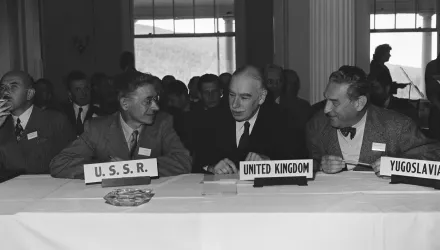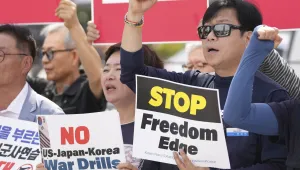International Security is America's leading peer-reviewed journal of security affairs.

ballistic missile, August 2017. A modified DF-21 was used in 2007 to conduct an anti-satellite operation.
This policy brief is based on “Escalation through Entanglement: How the Vulnerability of Command-and-
Control Systems Raises the Risks of Inadvertent Nuclear War,” which appears in the summer
2018 issue of International Security.
Bottom Lines
- Entanglement. The nuclear command, control, communication, and intelligence (C3I) systems of the United States, China, and Russia are becoming increasingly vulnerable to nonnuclear attack. Moreover, they all use at least some dual-use assets that support both nuclear and nonnuclear operations.
- Inadvertent escalation. In a conventional conflict between the United States and China or Russia, either of the belligerents might launch nonnuclear attacks against its opponent’s dual-use C3I assets for the purpose of undermining that opponent’s nonnuclear operations. Such attacks could, however, spark inadvertent escalation that culminated in nuclear use.
- Risk reduction. For the time being, unilateral measures offer the most promising approach to risk reduction. In particular, the U.S. Department of Defense should ensure that inadvertent escalation risks are given due consideration within acquisitions, war planning, and crisis management.
The United States military is increasingly focused on preparing for the possibility of a major conflict against China or Russia. These preparations should include greater efforts to manage the risk of such a conflict inadvertently escalating into a nuclear war. This risk is rising today as a result of technological developments that are increasing both the likelihood and effectiveness of nonnuclear attacks against key nuclear command, control, communications, and intelligence assets. Such “entanglement” exacerbates the risk of U.S. nonnuclear strikes on Russia or China sparking inadvertent escalation—a danger that analysts have warned about over the past decade or so and that some military planners and civilian policymakers recognize. Entanglement also creates the risk of inadvertent escalation as a result of Chinese or Russian strikes on the United States—a possibility that has scarcely been considered since the end of the Cold War.
Drivers of Entanglement
Nuclear C3I assets can be entangled with nonnuclear weapons in one or both of two ways: they can be dual use—that is, used to enable nonnuclear as well as nuclear operations—or vulnerable to nonnuclear attack. Entangled assets include satellites used for early warning, communication, intelligence, surveillance, and reconnaissance; ground-based radars and transmitters; and communication aircraft. Because many of these assets are space based or distant from probable theaters of operation, their vulnerability and the implications of attacks on them have been generally overlooked by analysts.
C3I assets are becoming more entangled as a result of four technological and doctrinal trends:
- Developments in nonnuclear technology—including in cyberweapons, anti-satellite capabilities, and high-precision conventional munitions—are increasing the threat to C3I assets.
- Changes in the design of nuclear C3I systems have exacerbated this threat. These changes include digitization, which creates the possibility of cyber interference, and, at least in the United States, decreased redundancy as a result of reduced funding.
- The United States’ nuclear C3I system is becoming increasingly reliant on dual-use assets, such as early-warning satellites used to detect an incoming nuclear attack and to cue defenses against nonnuclear ballistic missiles. Although less is known about the Chinese and Russian systems, they almost certainly use at least some dual-use assets. Russian ground-based radars, for example, provide warning of a nuclear attack and can track space objects, thus potentially enabling Moscow to attack U.S. satellites. Meanwhile, radars in China’s air-defense system help to protect Beijing’s nuclear and nonnuclear forces.
- The evolving conventional warfighting doctrines of China, Russia, and the United States appear to place a growing emphasis on threatening adversaries’ C3I assets, including dual-use ones.
Escalation Pathways
The developments described above are increasing the likelihood, in a major conventional conflict, of “incidental attacks,” in which one belligerent attacks its opponent’s dual-use C3I assets with the goal of undermining that opponent’s ability to conduct nonnuclear operations but, in the process, also undermines its ability to conduct nuclear operations.
Chinese or Russian incidental strikes on the United States could spark inadvertent escalation as a result of “misinterpreted warning” because Washington might mistake them for preparations for nuclear use. For example, if U.S. missile defenses were proving effective in intercepting Russian nonnuclear ballistic missiles fired at targets in Europe, Moscow might try to degrade those defenses by launching attacks on the U.S. early-warning system. Such attacks, however, might be misinterpreted by Washington as preparations to ensure that limited nuclear strikes by Russia against the U.S. homeland could not be intercepted.
Even if incidental attacks against the United States did not lead Washington to conclude that a nuclear strike by its adversary was imminent, they could still spark escalation by threating to close the “damage-limitation window.” U.S. nuclear strategy aims to limit the damage that the United States would suffer in a nuclear war. To have any chance of doing so, the United States would be reliant on sophisticated enabling capabilities, such as intelligence, surveillance, and reconnaissance assets to locate mobile missiles and early-warning assets to cue missile defenses. If, for example, in a conventional conflict China started to degrade the U.S. C3I system (or even if the United States was worried it might do so), Washington could fear that its window of opportunity for conducting effective damage-limitation operations might have closed by the time the war turned nuclear.
It is possible that the United States might respond to misinterpreted warning or the closing of the damage-limitation window by using nuclear weapons—either to try to disarm its opponent or, more likely, in a limited way to try to scare the opponent into backing down. Indeed, the Trump administration’s Nuclear Posture Review explicitly threatens to consider the use of nuclear weapons in response to “non-nuclear strategic attacks” on C3I capabilities associated with U.S. or allied nuclear forces. That said, other less extreme—but still escalatory—U.S. responses would probably be more likely. For example, the United States could threaten to use nuclear weapons if the opponent continued to attack U.S. C3I assets (and, if the opponent continued its attacks, Washington might follow through on its threat). Alternatively, the United States could launch nonnuclear operations—such as strikes on anti-satellite weapons deep within China or Russia—to try to preserve surviving C3I capabilities. Such operations could prove particularly escalatory if the United States had previously refrained from such deep strikes in an effort to keep the war limited.
Incidental strikes by the United States on dual-use Chinese or Russian C3I capabilities could also spark inadvertent escalation—although, in this case, another escalation pathway, known as "crisis instability," would be the most likely. Specifically, U.S. strikes might be misinterpreted by the target as part of an effort to undermine its nuclear deterrent (the target might well worry that nuclear or nonnuclear attacks on its nuclear forces would follow). Again, it is possible that such misperception might lead the target to use nuclear weapons directly, although nuclear threats would be more likely. Alternatively, the target could take steps to enhance the survivability of its nuclear forces by, for example, dispersing mobile missiles, which might be misinterpreted by Washington as an aggressive move.
Policy Implications for the United States
In theory, it is possible to imagine a cooperative process, in which China, Russia, and the United States agreed to reciprocal risk-mitigation measures, such as limits or prohibitions on capabilities that pose particularly acute threats to dual-use C3I assets. In practice, for a variety of reasons, including the poor state of U.S.-Chinese and particularly U.S.-Russian relations, such a process would be a nonstarter today—though intergovernmental dialogues designed to build shared understanding of the risks might be closer to the realm of the possible.
In practice, unilateral steps offer the most productive path forward. Today, the management of inadvertent escalation risks tends to fall between the bureaucratic cracks in the Pentagon. To correct this problem, a senior official within the U.S. Department of Defense—probably the undersecretary of defense for policy, who is already responsible for reviewing war plans to ensure that they comport with civilian guidance—should be tasked with ensuring that inadvertent escalation risks (including, but not limited to, those stemming from entanglement) are properly factored into decisions about acquisitions, war planning, and crisis management.
An immediate task is simply to raise awareness of entanglement and its implications among civilian officials and military officers. Inadvertent escalation could be triggered by the United States’ misperceiving an adversary’s intentions or by an adversary misperceiving the United States’ intentions. Awareness that such misperception was possible, by itself, could lead to the development of capabilities and war plans that were less prone to sparking escalation and, even more important, to restraint in crises and conflicts.
Increased awareness would not always be enough by itself. More active intervention in acquisitions and war planning would be needed, probably on a regular basis, to ensure that decisionmakers paid due attention to escalation risks in weighing them against more traditional military, strategic, and financial considerations.
Over the next few years, a priority should be to ensure that the implications of entanglement are properly considered within the acquisition process. The United States has recently started to recapitalize its nuclear C3I system. Whether because of bureaucratic inertia or some other reason, there appears to be little appetite within the Pentagon to rethink the United States’ current reliance on a relatively small number of highly capable dual-use C3I assets, even though such assets are becoming increasingly vulnerable to nonnuclear weapons.
To be sure, there is no perfect alternative. Various alternative architectures—including the use of C3I assets reserved exclusively for nuclear operations and the deployment of large numbers of less capable assets—have been suggested. All create real trade-offs, however, and the optimum solution is far from clear. What is clear is that unless the implications of entanglement are properly considered within the process of designing the United States’ future nuclear C3I system, the architecture that is ultimately adopted is unlikely to be the optimum one.
Related Resources
James N. Miller Jr. and Richard Fontaine, “A New Era in U.S.-Russian Strategic Stability: How Changing Geopolitics and Emerging Technologies Are Reshaping Pathways to Crisis and Conflict” (Cambridge, Mass., and Washington, D.C.: Belfer Center for Science and International Affairs, John F. Kennedy School of Government, Harvard University, and Center for a New American Security, September 2017), p. 19, https://s3.amazonaws.com/files.cnas.org/documents/CNASReport-ProjectPathways-Finalb.pdf?mtime=20170918101504.
Barry R. Posen, Inadvertent Escalation: Conventional War and Nuclear Risks (Ithaca, N.Y.: Cornell University Press, 1991).
Caitlin Talmadge, “Would China Go Nuclear? Assessing the Risk of Chinese Nuclear Escalation in a Conventional War with the United States,” International Security, Vol. 41, No. 4 (Spring 2017), pp. 50–92, doi:10.1162/ISEC_a_00274.
Tong Zhao and Li Bin, “The Underappreciated Risks of Entanglement: A Chinese Perspective,” in James M. Acton, ed., Entanglement: Russian and Chinese Perspectives on Non-Nuclear Weapons and Nuclear Risks (Washington, D.C.: Carnegie Endowment for International Peace, 2017), pp. 47–75, http://carnegieendowment.org/files/Entanglement_interior_FNL.pdf.
James M. Acton holds the Jessica T. Matthews chair and is co-director of the Nuclear Policy Program at the Carnegie Endowment for International Peace.
International Security is America’s leading peer-reviewed journal of security affairs. It provides sophisticated analyses of contemporary, theoretical, and historical security issues.
International Security is edited at Harvard Kennedy School’s Belfer Center for Science and International Affairs and is published by The MIT Press.
For more information about this publication, please contact the International Security publications coordinator at 617-495-1914.
Statements and views expressed in this policy brief are solely those of the author and do not imply endorsement by Harvard University, the Harvard Kennedy School, or the Belfer Center for Science and International Affairs.
Acton, James. “Inadvertent Escalation and the Entanglement of Nuclear Command-and-Control Capabilities.” October 29, 2018



